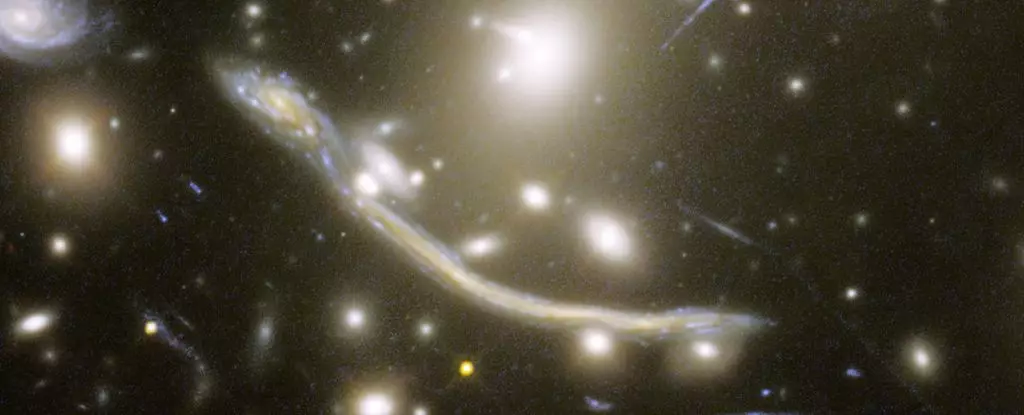The expanse of the universe presents a profound challenge to astronomers seeking to unravel the mysteries of cosmic evolution. The immense distances and the age of light that travels across the universe often limit our ability to observe distant celestial bodies. However, with the advent of powerful astronomical tools, such as the James Webb Space Telescope (JWST), we are now poised to break through these observational boundaries. Recent advancements have enabled scientists to resolve individual stars in galaxies billions of light-years away, opening doors to unprecedented insights into the formation and evolution of galaxies in the distant universe.
Astronomers have long grappled with the inherent limitations of observing far-off galaxies. Typical stars in these distant galaxies are so faint that detecting them individually has historically been a formidable task. Prior attempts, such as those using the Hubble Space Telescope, revealed only a handful of stars. The overwhelming distance and the limitations of light travel meant that only the most luminous objects, such as large galaxies, were visible. Despite these challenges, technological advancements bring the promise of a greater understanding of our universe.
The JWST has significantly advanced our capabilities to observe the far reaches of the cosmos. Recently, a team of astronomers led by Fengwu Sun from the University of Arizona made a groundbreaking discovery, identifying 44 distinct stars within a galaxy whose light has traveled for approximately 6.5 billion years to reach Earth. This achievement not only underscores the potential of modern space telescopes but also marks the first time a large number of individual stars have been resolved in such a distant galaxy.
This voluminous star resolution demonstrates JWST’s enhanced observational prowess, enabling astronomers to gain a clearer picture of stellar compositions and their environments. This newfound ability opens up avenues for studying phenomena that were previously beyond our analytical reach, such as dark matter’s role in the lensing effects observed in these galaxies.
Astronomers employ the principles of general relativity to address the limitations imposed by distance. Gravitational lensing, a phenomenon that occurs around massive celestial bodies, manipulates the path of light traveling through space-time. When light emitted from distant galaxies passes near large clusters of galaxies, the gravitational field can bend that light, producing multiple images and magnifying them in a manner akin to a warped lens.
The Dragon Arc, a stunning visual phenomenon resembling a Chinese dragon, is a captivating example of this effect. It consists of distorted images of a single galaxy, separated into head and tail formations caused by the gravitational pull of the Abell 370 galaxy cluster, situated almost 4 billion light-years from Earth. Though the distant light appears jumbled, researchers can reverse-engineer the lensing effects to reconstruct images closer to their original forms, creating a clear visual of the background galaxies while also magnifying their appearance for easier study.
Beyond the macro-level gravitational lensing effects dictated by massive galaxy clusters, individual stars drifting within the same space can yield yet another layer of optical distortion, known as microlensing. A research team led by Yoshinobu Fudamoto of Chiba University discovered this phenomenon while examining the blurred light of the Dragon Arc. They successfully identified individual stars that had previously eluded detection through traditional means. These 44 stars represent a significant leap in observational capacity, as such a number had never been recorded in such a distant context.
Fudamoto noted, “When we processed the data, we realized that there were many more individual star points evidenced in the data than we’d anticipated. This revelation offered a thrilling glimpse into an unseen part of the universe.”
Among the stars identified in the Dragon Arc, many are classified as red supergiants—massive stars nearing the end of their lifespans, typically characterized by their cooler temperatures and reddish hues. This distinction is pivotal because red supergiants, often more abundant than their blue counterparts in galaxies, provide key insights into stellar evolution and the lifecycle of galaxies far beyond our own.
The JWST’s capability to observe longer wavelengths of light, particularly red wavelengths, facilitates the detection of these cooler celestial bodies, illuminating aspects of cosmic evolution that have hitherto remained obscured. As more observations are conducted, we anticipate uncovering even more stars hidden within the cosmic lens of the Dragon Arc, continually enhancing our grasp of galaxy formation and the intricate tapestry of the universe.
The rise of advanced telescopes like the JWST heralds a remarkable period in the field of astronomy, allowing us to peer deeper into the universe and explore the vibrant tapestry of stars and galaxies over cosmic time. Each new discovery not only enriches our understanding of distant worlds but also paves the way for further exploration of the cosmos, inviting humanity to uncover more of its secrets in this boundless expanse. As we continue to make strides in astronomical studies, the potential for further breakthroughs remains limitless.


Leave a Reply